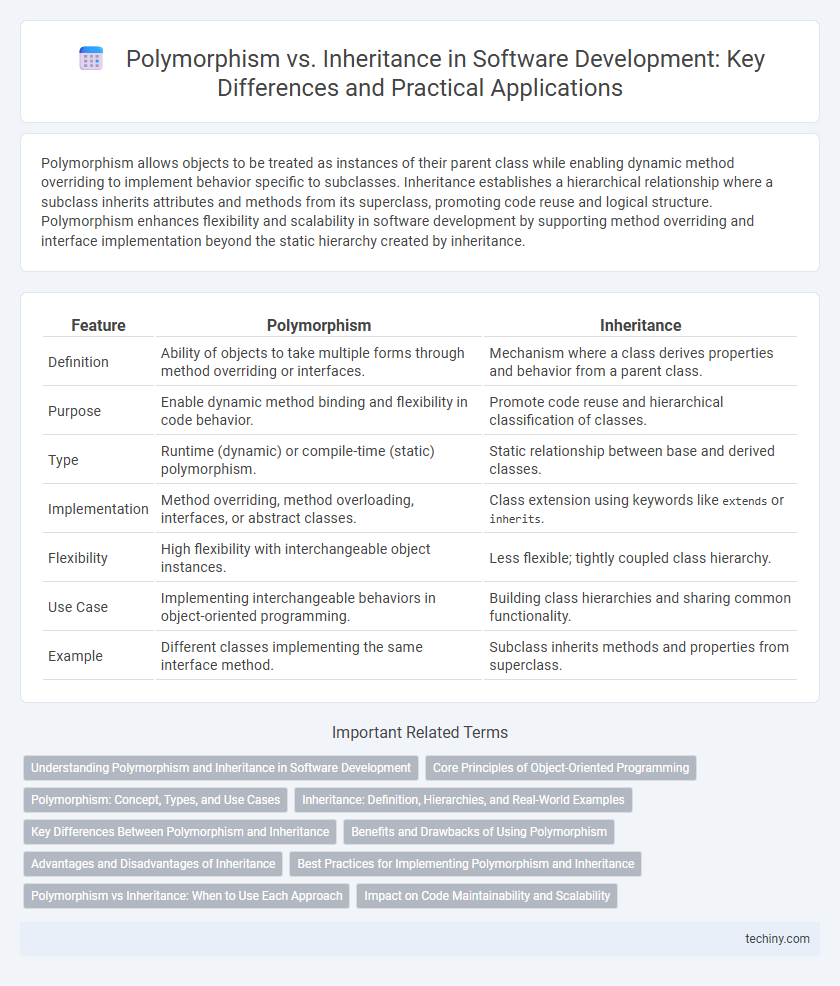Polymorphism allows objects to be treated as instances of their parent class while enabling dynamic method overriding to implement behavior specific to subclasses. Inheritance establishes a hierarchical relationship where a subclass inherits attributes and methods from its superclass, promoting code reuse and logical structure. Polymorphism enhances flexibility and scalability in software development by supporting method overriding and interface implementation beyond the static hierarchy created by inheritance.
Table of Comparison
| Feature | Polymorphism | Inheritance |
|---|---|---|
| Definition | Ability of objects to take multiple forms through method overriding or interfaces. | Mechanism where a class derives properties and behavior from a parent class. |
| Purpose | Enable dynamic method binding and flexibility in code behavior. | Promote code reuse and hierarchical classification of classes. |
| Type | Runtime (dynamic) or compile-time (static) polymorphism. | Static relationship between base and derived classes. |
| Implementation | Method overriding, method overloading, interfaces, or abstract classes. | Class extension using keywords like extends or inherits. |
| Flexibility | High flexibility with interchangeable object instances. | Less flexible; tightly coupled class hierarchy. |
| Use Case | Implementing interchangeable behaviors in object-oriented programming. | Building class hierarchies and sharing common functionality. |
| Example | Different classes implementing the same interface method. | Subclass inherits methods and properties from superclass. |
Understanding Polymorphism and Inheritance in Software Development
Polymorphism in software development enables objects to be treated as instances of their parent class rather than their actual class, allowing for dynamic method overriding and enhanced flexibility in code behavior. Inheritance facilitates code reuse by allowing new classes to derive properties and methods from existing ones, establishing a hierarchical relationship between classes. Understanding these concepts improves software maintainability and scalability by promoting modular design and reducing redundancy.
Core Principles of Object-Oriented Programming
Polymorphism enables objects to be treated as instances of their parent class, allowing methods to function differently based on the actual object's class, which enhances code flexibility and reusability. Inheritance establishes a hierarchy where a subclass inherits properties and behaviors from a superclass, facilitating code organization and the creation of more specific object types. Both principles are fundamental in object-oriented programming, driving efficient code management and extensibility through encapsulation and abstraction.
Polymorphism: Concept, Types, and Use Cases
Polymorphism in software development enables objects to be treated as instances of their parent class rather than their actual class, facilitating dynamic method binding and improving code flexibility. The primary types include compile-time polymorphism, achieved through method overloading and operator overloading, and run-time polymorphism, implemented via method overriding with inheritance and interfaces. Use cases of polymorphism span from designing scalable architectures to implementing plug-and-play modules in object-oriented programming, enhancing code reusability and maintainability.
Inheritance: Definition, Hierarchies, and Real-World Examples
Inheritance in software development is a fundamental object-oriented programming concept that allows a class to inherit properties and methods from another class, establishing a hierarchy between parent (superclass) and child (subclass) classes. This hierarchical structure promotes code reusability and logical organization, enabling subclasses to override or extend parent class functionalities. Real-world examples include a "Vehicle" superclass with subclasses like "Car" and "Bike," where shared attributes like speed or fuel type are inherited, demonstrating practical implementation of inheritance hierarchies.
Key Differences Between Polymorphism and Inheritance
Polymorphism enables objects of different classes to be treated as instances of a common superclass, allowing methods to behave differently based on the object's actual class, enhancing flexibility and code reusability. Inheritance establishes a hierarchical relationship where a subclass inherits properties and methods from a superclass, promoting code reuse and logical organization through class extension. While inheritance deals with the "is-a" relationship and code structure, polymorphism focuses on the "many forms" behavior enabling dynamic method binding and runtime method overriding.
Benefits and Drawbacks of Using Polymorphism
Polymorphism in software development enhances code flexibility by allowing objects of different classes to be treated as instances of a common superclass, promoting extensibility and reducing code duplication. It can improve runtime behavior through dynamic method binding, enabling easier maintenance and scalability in complex systems. However, excessive use of polymorphism may introduce performance overhead and increase code complexity, making debugging and understanding program flow more challenging.
Advantages and Disadvantages of Inheritance
Inheritance promotes code reusability by allowing new classes to derive properties and methods from existing ones, thus simplifying maintenance and reducing redundancy. However, it can lead to tight coupling, making changes in the parent class potentially disruptive to all derived subclasses, which complicates scalability and debugging. Overuse of inheritance can also cause fragile base class problems, limiting flexibility and increasing dependency issues in complex software development.
Best Practices for Implementing Polymorphism and Inheritance
Implement polymorphism by designing interfaces or abstract classes that define common behaviors, allowing multiple classes to implement or extend them for flexible code reuse. Use inheritance sparingly to avoid deep or complex hierarchies, favoring composition or interface implementation to enhance maintainability and scalability. Follow SOLID principles, especially the Liskov Substitution Principle, to ensure that subclass objects can seamlessly replace superclass objects without altering program correctness.
Polymorphism vs Inheritance: When to Use Each Approach
Polymorphism should be used when you need to design flexible systems that can process objects differently based on their data type or class, facilitating code reusability and dynamic method binding. Inheritance is appropriate when creating hierarchical relationships where subclasses inherit attributes and behaviors from parent classes, promoting code organization and reducing redundancy. Choosing polymorphism over inheritance enhances scalability and maintainability in complex software architectures by enabling objects to be treated interchangeably through shared interfaces.
Impact on Code Maintainability and Scalability
Polymorphism enhances code maintainability and scalability by allowing objects to be treated as instances of their parent class, enabling flexible method overriding without modifying existing code. Inheritance promotes code reuse by establishing hierarchical relationships but can lead to tight coupling and rigid class structures, making future changes more difficult. Leveraging polymorphism reduces dependency on specific class implementations, fostering extensible architectures and simplifying feature expansion in software development.
Polymorphism vs Inheritance Infographic

 techiny.com
techiny.com